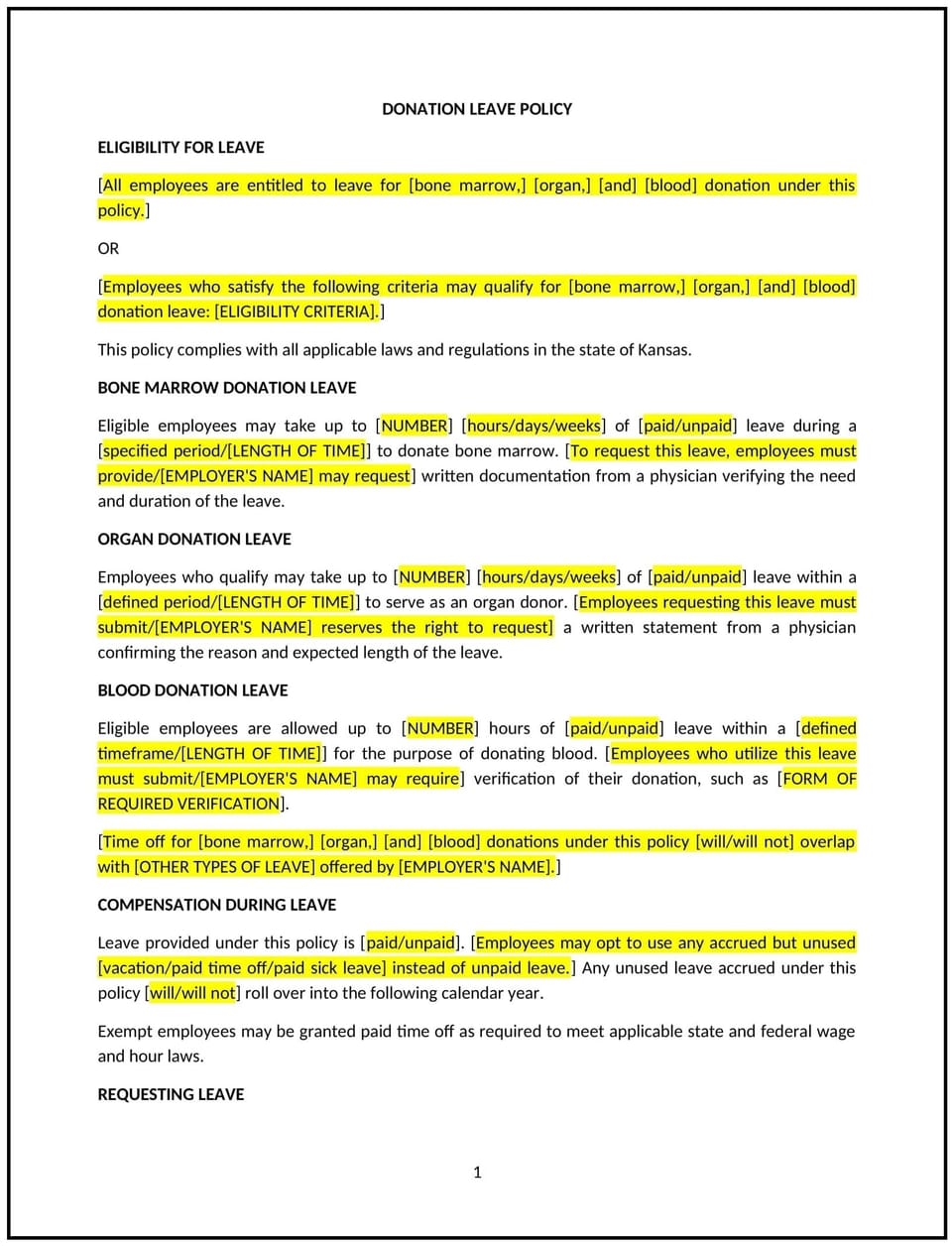Donation leave policy (Kansas): Free template

Donation leave policy (Kansas)
A donation leave policy helps Kansas businesses provide employees with paid or unpaid leave to participate in volunteer work, donate blood, or contribute to charitable causes during work hours. This policy outlines the conditions under which employees can use donation leave, the types of activities covered, and the approval process for time off.
By implementing this policy, businesses can encourage community involvement, foster employee engagement, and contribute to local causes while maintaining operational efficiency.
How to use this donation leave policy (Kansas)
- Define eligible activities: Businesses should specify the types of charitable activities covered, such as volunteering at nonprofits, participating in blood drives, or supporting disaster relief efforts.
- Establish leave allocation: Businesses should determine how much leave employees are entitled to for donation purposes, such as a certain number of hours per year or per event.
- Set approval processes: Employees should be required to request donation leave in advance, outlining the activity, date, and duration. The policy should specify who approves these requests (e.g., managers or HR).
- Communicate documentation requirements: Businesses may require employees to provide documentation or proof of participation in donation activities to ensure leave is used appropriately.
- Address usage limits: Businesses should define any limitations, such as a cap on the number of days employees can take for donation leave each year.
- Consider both paid and unpaid leave: Businesses should clarify whether donation leave is paid, unpaid, or a combination of both, depending on the activity or duration of leave.
- Review and update regularly: Businesses should periodically evaluate the policy to ensure it aligns with evolving community needs and employee preferences.
Benefits of using a donation leave policy (Kansas)
- Enhances employee engagement: Provides employees with opportunities to contribute to meaningful causes, improving morale and job satisfaction.
- Strengthens community relations: Demonstrates the business's commitment to local causes and enhances its reputation as a responsible corporate citizen.
- Encourages volunteerism: Supports employees’ desire to give back to their communities without negatively impacting their work-life balance.
- Builds a positive workplace culture: Promotes a culture of social responsibility and encourages teamwork and collaboration outside of work.
- Improves employee retention: Employees are more likely to stay with a business that supports their personal values and charitable efforts.
- Reduces administrative burden: A structured policy for donation leave makes it easier for businesses to manage and track time off for charitable purposes.
Tips for using this donation leave policy (Kansas)
- Clearly communicate the policy: Businesses should ensure all employees are aware of the donation leave policy, how to request leave, and which activities are eligible.
- Monitor leave usage: Businesses should track donation leave to ensure it is used appropriately and within the defined limits.
- Encourage participation: Businesses can promote donation leave by highlighting community service opportunities or organizing company-wide volunteer events.
- Review the policy regularly: Businesses should assess the policy annually to ensure it aligns with community needs and employee engagement goals.
- Set guidelines for proof of participation: Businesses should establish reasonable documentation requirements to confirm that donation leave is used for legitimate charitable activities.
- Be flexible with scheduling: Businesses should offer flexibility in scheduling donation leave to accommodate a wide range of charitable activities.
Q: Why should Kansas businesses implement a donation leave policy?
A: Businesses should implement a donation leave policy to encourage employees to give back to their communities, improve employee engagement, and demonstrate corporate social responsibility.
Q: What types of charitable activities should businesses cover under donation leave?
A: Businesses should include activities such as volunteering with nonprofit organizations, donating blood, and participating in community-driven events or disaster relief efforts.
Q: How much donation leave should businesses provide to employees?
A: Businesses should determine a reasonable number of hours or days per year that employees can use for donation leave. This may vary depending on the type of activity or the duration of the event.
Q: Is donation leave paid or unpaid?
A: Businesses should specify whether donation leave is paid, unpaid, or a combination, depending on the type of activity or the duration of leave. For example, businesses may offer paid leave for blood donation and unpaid leave for extended volunteer projects.
Q: Do employees need to provide documentation for donation leave?
A: Businesses should require employees to provide documentation, such as proof of participation or an event verification, to ensure donation leave is being used for charitable purposes.
Q: How often should businesses review and update their donation leave policy?
A: Businesses should review their donation leave policy annually or whenever there are changes in community needs, employee feedback, or business priorities.
This article contains general legal information and does not contain legal advice. Cobrief is not a law firm or a substitute for an attorney or law firm. The law is complex and changes often. For legal advice, please ask a lawyer.


